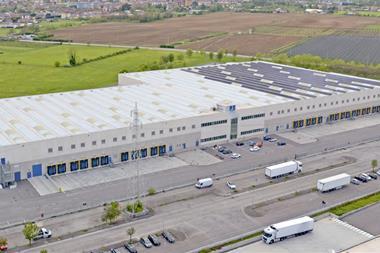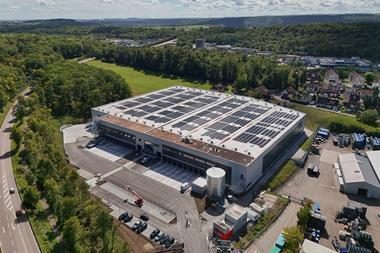A rapidly expanding sector, logistics offers a more secure investment and higher income return than more mainstream sectors. But there are concerns for investors, as Christine Senior reports
Traditionally the "blue banana" has covered the most favoured locations in European logistics. This geographical area stretching from London at one end of the curve through the Netherlands, Germany and eastern France to northern Italy takes in prosperous economic areas linked by good communications routes. Though still an important logistics location the curve has in recent years been pulled eastwards as the more recent EU entrants in central and eastern Europe have enjoyed economic growth on the back of their EU membership.
Globalisation has had an enormous impact on demand for logistics as increasingly worldwide markets become more interlinked, and the demand for logistics facilities increases as more and more goods are transported around the world to satisfy consumer demand. The fall of the Berlin wall, and the consequent development of the former eastern bloc states, now EU members, have increased the flow of freight across European borders, increasing demand for logistics facilities. And the EU itself, with its Trans-European Network for Transport designed to extend transport infrastructure to link the margins of the EU to its core has been integral to the development of swifter and easier goods flow through development of roads, airports, railways, shipping routes and waterways.
Outsourcing of logistics by companies over the last 20 years has increased demand for specialised facilities. Rather than purely warehousing and transport of goods, logistics has expanded to include many more value added facilities such as packaging, assembly, and order processing. Logistics has also increased as a sub sector of the industrial segment of real estate, with warehousing edging out manufacturing to take a bigger share. Location is key to success of logistics facilities. Those close to good transport links will be most in demand.
"Logistics is a global business driven by infrastructure improvement," says James Rushworth, director of European property at Standard Life Investments. "There are new motorways being constructed through Poland into the Czech Republic and into the Balkans. Those logistics corridors heavily influence where people wish to locate. They look at the speed of access to logistic corridors and the size of the populations they can service from those locations."
Ports and airports will always prove magnets for logistics operators, as strategic locations for the movement of goods. And they continue to gain in importance.
"Seaports and airports are important nodes for logistics players as they are very strategic," says Ali Nassiri, investment analyst (logistics) at ING Real Estate. "These locations clearly benefit from the globalisation trend, and from an investment point of view these are very interesting as they have a high level of supply constraints, offering a low risk profile and growth potential." But other prime sites are inland hubs, at the epicentre of multiple transport modes. Nassiri expects these to flourish: "I believe intermodal hubs will become more important, locations with access not just to road but also to rail, and waterways. We know there are huge constraints on roads because of congestion; sustainability is becoming more and more important. An example of an intermodel hub in the Netherlands close to Rotterdam is Moerdijk."
But location is not the only important factor for logistics investors. Property type, for example, also plays a part. Though most logistics buildings tend to look the same - like big sheds alongside motorways - that conceals a variety of uses, and not all offer the same facilities. Flexibility of usage is essential, according to Charles Pridgeon, head of continental European property business at Schroders.
Buildings should be as polyvalent as possible, he says. "As an owner we are conscious of buying the most modern types of facilities so you can do pretty much anything in them, from storing parts for aircraft assembly where you need a very clean environment, to storing paper where you need very heavy floorloads, through to the airport transit depots where goods come in and a few hours later go out and you have a huge amount of truck movement. Your building has got to be flexible enough so when one tenant moves out you can offer the building to as many types of tenants as possible."
Some buildings to be used purely for goods storage would not need to have lighting or heating, while a building to be used for goods assembly or packaging, where workers were employed, would need a different design. Installing heating only in part of the building to be occupied by workers, and leaving the rest unheated, saves energy costs.
Logistics does offer some advantages to investors compared to other real estate segments. An important consideration is that is relatively impervious to economic downturns. This is perhaps a something of a compensation for its relatively low rental growth.
"You have a fair amount of stability in downturns - when rents fall in downturns in the office sector, logistics tends to have more stable performance," says Pridgeon. "So it outperforms in downturns but it probably underperforms in times of a lot of growth. That statistically over the last 20 years or so has been the case. You have higher yields than office and retail, yet the risk may be far less, because you have longer leases, though the trend is towards shorter leases. Leases vary from country to country."
Also construction periods are relatively short. Buildings can be constructed in a matter of months, unlike office blocks, and start earning their keep sooner.
Rushworth commented: "If you have good fundamentals in the market you can undertake developments, and secure profits from that development, in a shorter time frame. You can build these building in six months whereas an office might take 18 months, so there is less risk of economy changing during the time you are undertaking development."
Future prospects also look good, as in future European logistics looks set to benefit from economic growth in Asia, and from further outsourcing.
"European logistics will benefit from import growth from containers from China and India, and the outsourcing of logistics activities," says Nassiri. "The level of outsourcing of logistics activities is still low, but growing at a sustainable level, maybe 7-8% per annum. Particularly smaller family owned companies still insource their logistics activities. A lot of growth is possible compared to the US."
The attraction of logistics, a subsector of the industrial sector, for pension fund investors is to diversify risk and enhance returns. This can be attributed to a couple of characteristics, says Nassiri.
"One reason is logistics offers a high income return component compared to office and retail as commercial property sectors," he says. "The second relates to volatility. Logistics has the lowest volatility, or maybe the lowest together with retail, of total return. That is due to the rent cycle which is rather flat: supply in logistics can adjust quickly to demand, and due to a higher income return component which creates less room for volatility in the capital growth."
Even if pension funds are turning to logistics investment for diversification reasons, for the moment allocations appear to be low. Dutch fund PME, for example, has allocated only 3% of its real estate portfolio. For ABP, logistics made up 8.2% of total European real estate exposure at the end of June this year. The majority of this is modern distribution warehousing with the remainder being multi-let industrial property.
"We invest in logistics because of its risk return profile, with relatively high yields and modest volatility," says Rutger van der Lubbe, senior portfolio manager, real estate, at ABP Investments. "As it has a relatively low correlation with the other real estate sectors, it is a useful diversifier too. Fundamentally the growth in trade volumes, particularly in relation to the volume of imports from China and the enlargement of European markets, makes it an interesting sector."
Michael Nielsen, head of real estate at Danish fund ATP, also cites diversification as the attraction of logistics.
"We see it as a diversifier to our exposure to office, retail and residential," he says. "We can see that development of logistic investment does not exactly follow the same pattern as you see for office and for retail for example. If there is huge demand for office space it doesn't mean there will be huge demand for logistics."
But in addition to acting as a diversifier it has also made a useful contribution to returns: "We have had some attractive returns from logistics and we have seen this segment getting more and more professional," he says. "We have some very professional operators in the market, for example ProLogis - they are able to deliver very efficient tailor-made logistics property for a number of tenants all over Europe."
ATP's property portfolio is split into two: domestic which is managed directly, and non domestic, which is accessed mainly via unlisted funds. The domestic portfolio has no exposure to logistics, because Nielsen considers it very specialist, requiring specific management skills. Non-domestic investments include both specialist logistics funds and allocations within diversified funds.
Another pension fund investor who is positive about European logistics is Hermann Aukamp, CIO and director of real estate of the Nordrheinische Ärzteversorgung. The current allocation to logistics is less than 2%, but Aukamp is planning to increase this to 5%. This will be achieved through both listed and unlisted vehicle (though Aukamp has some concerns currently about volatility in the listed companies).
Aukamp likes logistics for its reliability: "It's stable income and safe, but never exciting," he says. "If you have good size, and good tenant quality it has stable income and it's not so volatile as office."
For UK pension funds allocations to non domestic property remain very low, so any investment decisions on logistics allocations would most likely delegated to property managers to act on an opportunistic basis:
John Hastings, a partner at Hymans Robertson, said: "I think most people diversifying into Europe would use one of their existing managers and they would either be looking for some broad European exposure that may be on a higher yield basis than the UK is at this point.
Or alternatively they might be looking selectively at a mix of more interesting opportunities. I suppose the question we would have is: why go to Europe instead of going into the wider globe? So then it would then it would come down to the managers themselves doing the work to find where the most attractive opportunities might be."
As for the pitfalls of investing in logistics Van der Lubbe sums these up as the relative immaturity of the market and limited rental growth potential.
"My main concern is that in comparison with other European property markets the logistics market is still relatively small and immature," he says. "In addition, the relative absence of supply constraints and the geographically extensive areas considered by tenants for site selection means that there is typically little rental growth."
Another hurdle for institutional investors, whose allocation to the sector is limited, is the specialist knowledge required to get the investments right. Those managers with specific logistics experience, running dedicated logistics funds, such as ProLogis, are most likely to have the expertise to be successful. Specialist skills are essential, says Thomas Beyerle, head of research and strategy at DEGI.
"To make an add-on to logistics with 2-3% of a portfolio is not sustainable," says Beyerle. "To make the big jump in these markets you have to be one of the specialists and have your own specialist fund. Logistics is more of a closed shop for specialist investors coming from the opportunistic side. You have to understand how the market really works."
Aukamp has some concerns about overbuilding, stemming from the short building times of logistics property: "In some locations it only takes six months to build these facilities, and there is overbuilding in some areas but if you concentrate on logistic hubs where you don't get permission easily you can limit this to a certain extent."
Threats to the sector come from European Union legislative changes, especially the emphasis on environmental protection and health and safety measures. For instance the European drive time initiative to limit the time lorry drivers could stay on the road forced companies to reassess their logistics requirements, to identify the best locations to service customers. Similarly environmental rules on energy consumption, and the requirement for sellers and landlords to provide energy performance certificates, make older buildings less attractive.
The wider environmental impact is also an issue. "Lots of trucks driving around is seen as bad for the planet," says Rushworth. "The effect that has on the way people operate their logistics can affect whether property is in the right location."












